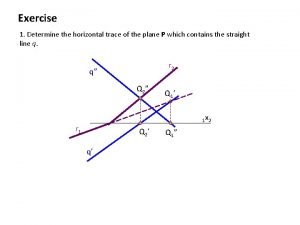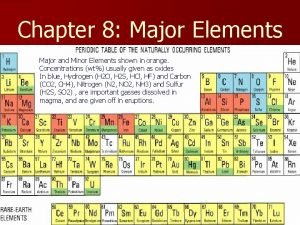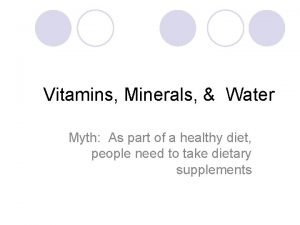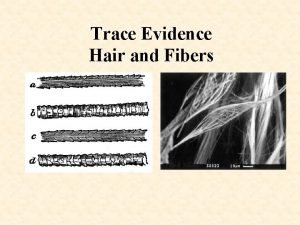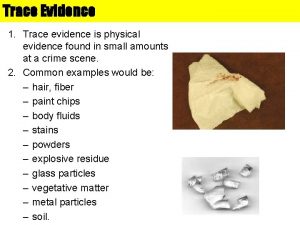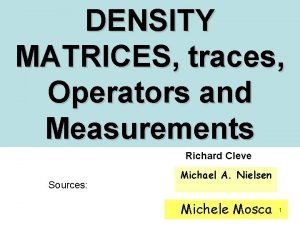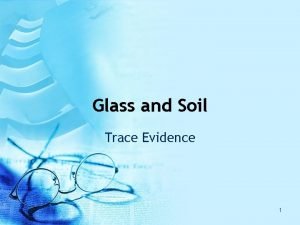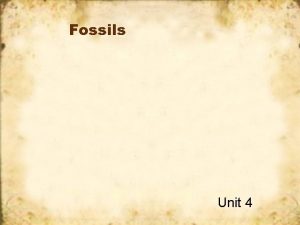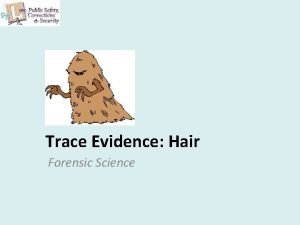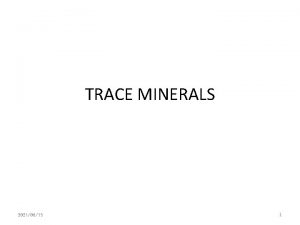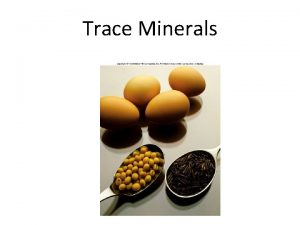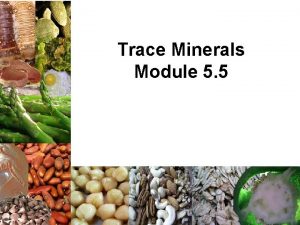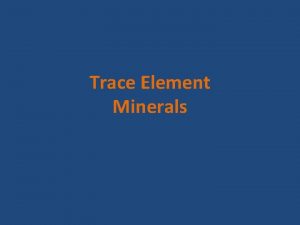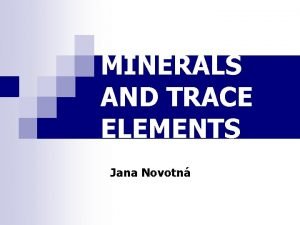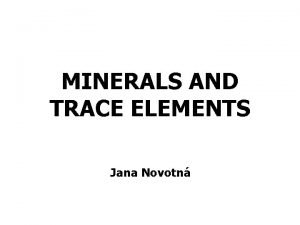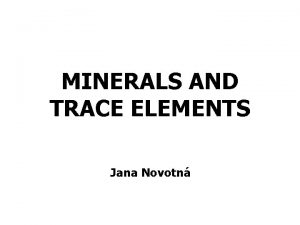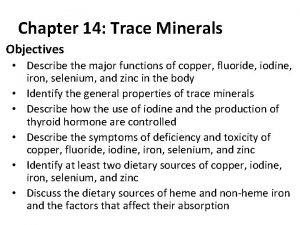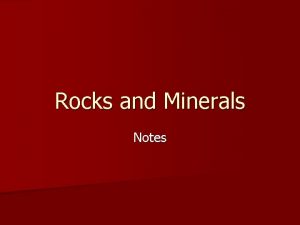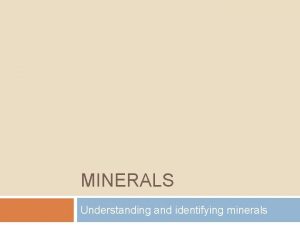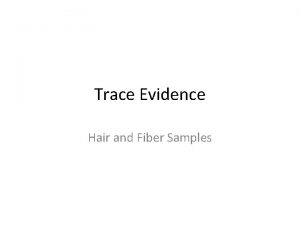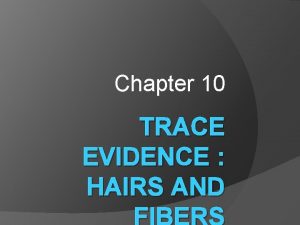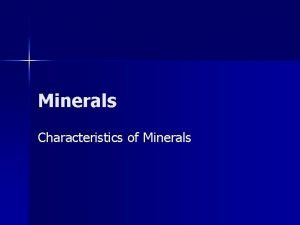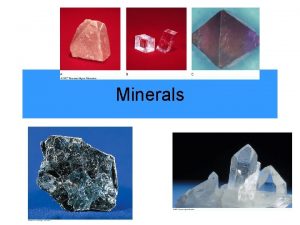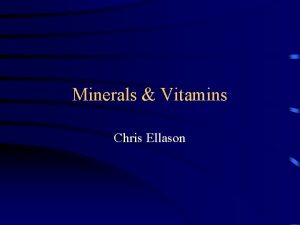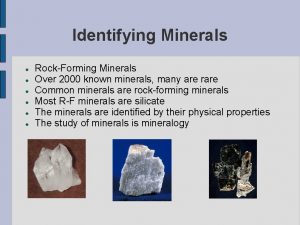Major Minerals and Trace What are minerals Minerals























































- Slides: 55

Major Minerals and Trace

What are minerals? -Minerals are inorganic substances that are found in soil and rocks. They are essential nutrients that the body needs to survive and carry out daily functions and processes. -Minerals keep you healthy and

What are the main functions of minerals in our body? -Minerals are required by all humans in small amounts. -They help our body carry out functions that are necessary to have a healthy and long life -Minerals come from the earth and therefore available for us in a variety of plant foods, animal foods, and even in the water we drink.

Major Minerals (Macrominerals) • Sodium • Chloride • Potassium • Calcium • Phosphorus • Magnesium • Sulfur Major Minerals or Macrominerals are minerals that are needed by the body in larger amounts since they are more essential to our body.

Sodium is the primary positive ion found in the blood and body fluids; it is also found in every cell although it is mainly extracellular, working closely with potassium, the primary intracellular mineral. About 60 percent of body sodium is in the fluids around cells (extracellular), 10 percent is inside the cells, and around 30 percent is found in the bones. Sodium is one of the electrolytes, along with potassium and chloride, and is closely tied in with the movement of water; "where sodium goes, water goes. "

Sodium Function: Needed for proper fluid balance, nerve transmission, and muscle contraction Sources: Table salt, soy sauce; large amounts in processed foods; small amounts in milk, breads, vegetables, and unprocessed meats

Chloride The element chlorine itself is a poisonous gas that is soluble in water; in nature and in our body, it exists primarily as the chloride anion, the negatively charged ion that joins with cations such as sodium to make salt (sodium chloride) and with hydrogen to make stomach acid (hydrochloric acid). Chloride makes up about 0. 15 percent of our body weight and is found mainly in the extracellular fluid along with sodium. Less than 15 percent of the body chloride is found inside the cells, with the highest amounts within the red blood cells.

Chloride Function: Needed for proper fluid balance, stomach acid Sources: Table salt, soy sauce; large amounts in processed foods; small amounts in milk, meats, breads, and vegetables

Sources of Sodium & Chloride Bread Table Salt Milk Soysauce Vegetables and Unprocessed Meat

Potassium is a very significant body mineral, important to both cellular and electrical function. It is one of the main blood minerals called "electrolytes" (the others are sodium and chloride), which means it carries a tiny electrical charge (potential). Potassium is the primary positive ion (cation) found within the cells, where 98 percent of the 120 grams of potassium in the body is found.

Potassium Function: Needed for proper fluid balance, nerve transmission, and muscle contraction Sources: Meats, milk, fresh fruits and vegetables, whole grains, legumes

Sources of Potassium Meats Fruits and Vegetables Milk Grains Legumes

Calcium is the most abundant mineral in the human body and one of the most important. The calcium topic is huge and complex; let me try to make it concise and simple. This mineral constitutes about 1. 5 -2. 0 percent of our body weight. Almost all (98 percent) of our approximately three pounds of calcium is contained in our bones, about 1 percent in our teeth, and the rest in the other tissues and circulation

Calcium Function: Important for healthy bones and teeth; helps muscles relax and contract; important in nerve functioning, blood clotting, blood pressure regulation, immune system health Sources: Milk and milk products; canned fish with bones (salmon, sardines); fortified tofu and fortified soy milk; greens (broccoli, mustard greens); legumes

Sources of Calcium Canned Fishes Legumes Milk and Dairy Products Broccoli Fortified Tofu and Milk Mustard Greens

Phosphorus the second most abundant element (after calcium) present in our bodies, makes up about 1 percent of our total body weight. It is present in every cell, but 85 percent of the phosphorus is found in the bones and teeth. In the bones, phosphorus is present in the phosphate form as the bone salt calcium phosphate in an amount about half that of the total calcium.

Phosphorus Function: Important for healthy bones and teeth; found in every cell; part of the system that maintains acid-base balance Sources: Meat, fish, poultry, eggs, milk, processed foods (including soda pop)

Sources of Phosphorus Meat Seafood Lentils Processed Foods Dairy Products

Magnesium is a very important essential macromineral, even though there are only several ounces in the body (0. 05 percent of body weight). It is involved in several hundred enzymatic reactions, many of which contribute to production of energy and cardiovascular function. Magnesium is the "iron" of the plant worldas iron is to hemoglobin, magnesium is to chlorophyll, the "blood" pigment of plants. The central atom of the chlorophyll structure is magnesium.

Magnesium Function: Found in bones; needed for making protein, muscle contraction, nerve transmission, immune system health Sources: Nuts and seeds; legumes; leafy, green vegetables; seafood; chocolate; artichokes; "hard" drinking water

Sources of Magnesium Meat Seafood Lentils Processed Foods Dairy Products

Sulfur is an interesting nonmetallic element that is found mainly as part of larger compounds. It is not discussed much in nutrition books, mainly because it has not been thought to be essential—that is, sulfur deficiency does not cause any visible problems. Sulfur represents about 0. 25 percent of our total body weight, similar to potassium. The body contains approximately 140 grams of sulfur-mainly in the proteins, although it is distributed in small amounts in all cells and tissues

Sulfur Function: Found in protein molecules Sources: Occurs in foods as part of protein: meats, poultry, fish, eggs, milk, legumes, nuts

Sources of Sulfur Meat Seafood Legumes Nuts Dairy Products

Trace Minerals (Microminerals) • Iron • Zinc • Iodine • Selenium • Copper • Manganese • Fluoride • Chromium • Molybdenum Trace Minerals or Microminerals are minerals that are needed by the body in trace or small amounts.

Iron absorbed into the blood is usually bound to the protein transfer in and goes mainly to the bone marrow, where it can be used to make red blood cells. Iron absorption from the intestinal tract is a very subtle process; poor absorption is one of the main reasons, along with low-iron diets, that iron deficiency is so prevalent. Along with calcium, which is also difficult to absorb, iron and zinc are the minerals most commonly deficient in our diet.

Iron Function: Part of a molecule (hemoglobin) found in red blood cells that carries oxygen in the body; needed for energy metabolism Sources: Organ meats; red meats; fish; poultry; shellfish (especially clams); egg yolks; legumes; dried fruits; dark, leafy greens; iron-enriched breads and cereals; and fortified cereals

Sources of Iron Meat Dried Fruits Legumes Shellfish Leafy greens

Zinc is found in the body in small amounts, only about 2 -2. 5 grams total. Of the trace minerals, it is second in concentration to iron, with 33 ppm to iron's 60 ppm. (Although fluoride is found at 37 ppm in the average human body, it is still questionable whether it is essential. Zinc is often helpful in reducing healing time after surgery or burns, in many male prostate problems, in skin diseases, and in many other difficulties.

Zinc Function: Part of many enzymes; needed for making proteinand genetic material; has a function in taste perception, wound healing, normal fetal development, production of sperm, normal growth and sexual maturation, immune system health Sources: Meats, fish, poultry, leavened whole grains, vegetables

Sources of Zinc Fish Nuts Meat Yogurt Leafy greens

Iodine is a good example of a trace mineral whose deficiency creates a disease that is easily corrected by resupplying it in the diet. Goiter, an enlargement of the thyroid gland, develops when this important metabolic gland does not have enough iodine to manufacture hormones. Iodine itself is a poisonous gas, as are the related halogens chlorine, fluorine, and bromine. However, as with chlorine, the salts or negatively charged ions of iodine (iodides) are soluble in water, and iodine is essential to life in trace amounts.

Iodine Function: Found in thyroid hormone, which helps regulate growth, development, and metabolism Sources: Seafood, foods grown in iodinerich soil, iodized salt, bread, dairy products

Sources of Iodine Seafood Eggs Dairy Products Cranberries Navy Beans

Selenium functions as a component of the enzyme glutathione peroxidase, which accounts for its antioxidant function and thus its important contribution to the prevention of the twentieth-century plagues, cancer and cardiovascular disease. Selenium has become one of the most exciting nutrients of the 1970 s and 1980 s. Once classified solely as a toxic mineral, it is now regarded as an essential one, needed in small daily amounts.

Selenium Function: Served as an antioxidant (protect the body from damage caused by harmful molecules called oxygen free radicals. Sources: Meats, seafood, grains

Sources of Selenium Seafood Meat Grains

Copper has been known to be an essential trace mineral for some time. In recent years there has been more concern about copper toxicity than about getting the small amounts we need to make hemoglobin and perform other functions. Copper is present in all body tissues. The total amount in our bodies is about 75 -100 mg. , less than that contained in a copper penny.

Copper Function: Helps turn food into energy. Important for certain brain and nerve functions. Helps our body pull iron out of food to use. Sources: Legumes, nuts and seeds, whole grains, organ meats, drinking water

Sources of Copper Meat Legumes Nuts and Seeds Grains Water

Manganese little known and underrated by both doctors and the general public, is an essential mineral important to many enzyme systems in carrying out such functions as energy production, protein metabolism, bone formation The human body contains a total of about 15– 20 mg. of manganese. About half of that is in the bones, and the remainder is found in the liver, pancreas, pituitary gland, adrenal glands, and kidneys—the active metabolic organs. Manganese is present in many enzymes in body cells, particularly in the mitochondria.

Manganese Function: Important to turn food into energy. Also important for healthy bone and cartilage formation. Sources: Pecans, oatmeal, brown rice, spinach, almonds

Sources of Manganese Pecans Almonds Brown rice Spinach Oatmeal

Fluoride is probably not essential to humans, though it is helpful in strengthening the bones and teeth. It is found only in trace amounts, about 2 -3 grams, in the body, and most of that is in bones and teeth. The blood level of fluoride is about 0. 3 mg. per 100 ml.

Fluoride Function: Involved in formation of bones and teeth; helps prevent tooth decay Sources: Drinking water (either fluoridated or naturally containing fluoride), fish, and most teas

Sources of Fluoride Fishes Water with fluoride Teas

Chromium was long thought to be a toxic mineral until it was discovered in 1957 to be the essential part of glucose tolerance factor (GTF). Chromium is really considered an "ultra-trace" mineral, since it is needed in such small quantities to perform its essential functions. The blood contains about 20 parts per billion (ppb), a fraction of a microgram. Even though it is in such small concentrations, this mineral is important to health.

Chromium Function: Works closely with insulin to regulate blood sugar (glucose) levels Sources: Unrefined foods, especially liver, brewer's yeast, whole grains, nuts, cheeses

Sources of Chromium Whole Grains Cheeses Brewer’s Yeast

Molybdenum is now considered one of our essential trace minerals. It has been found to be essential in most mammals, as well as in all plants. We obtain it primarily from foods, but since it is often scarce in the earth's crust and therefore deficient in many soils, molybdenum deficiency can be a problem. The body contains minute amounts, about 9 mg. , of molybdenum. It is found mainly in the liver, kidneys, adrenal glands, bones, and skin,

Molybdenum Function: Part of some enzymes Sources: Legumes; breads and grains; leafy greens; leafy, green vegetables; milk; liver

Sources of Molybdenum Breads and Grains Leafy Greens Milk Legumes

Word Bank: Word Definition Antioxidant A substance in the body that prevents damage to cells. Blood Clotting A process that stops bleeding Enzymes Proteins in the body that speed up chemical reactions Fortified The addition of extra vitamins, minerals or fiber to a food product to increase its nutritional value. Hormones A chemical released by a gland or tissue that affects the activity of another cell or organ Metabolism All chemical reactions that help a body maintain life Thyroid Gland A gland in the neck that secretes hormones that regulate growth, development, metabolism, and reproductive function.

References/Sources: https: //extension. usu. edu/fscreate/files/uploads/Nutrient_Minerals/mi neral_sheet_copy. Jan. pdf http: //www. healthy. net/scr/article. aspx? Id=2076 https: //www. google. com. ph http: //www. emedicinehealth. com/minerals_their_functions_and_sour ces-health/article_em. htm

Thank You!!
 Antigentest åre
Antigentest åre Vertical trace and horizontal trace
Vertical trace and horizontal trace Minor elements
Minor elements Leave no trace principles for cub scouts
Leave no trace principles for cub scouts Transnet track and trace
Transnet track and trace Listen and read. which sister
Listen and read. which sister Dscsa track and trace
Dscsa track and trace Trace and say
Trace and say Track and trace ocr
Track and trace ocr Hyundai merchant marine track and trace
Hyundai merchant marine track and trace Grain track and trace solutions
Grain track and trace solutions Mip track and trace
Mip track and trace Minerals sources functions and deficiency chart
Minerals sources functions and deficiency chart Leave no trace canada
Leave no trace canada Tracer un arc surbaissé
Tracer un arc surbaissé Steam tracing manifold
Steam tracing manifold Hair growth
Hair growth Emile gourbin
Emile gourbin Trace evidence examples
Trace evidence examples Box trace recursion
Box trace recursion Box trace recursion
Box trace recursion Eugene hecht
Eugene hecht Image trace makes white box
Image trace makes white box Tracé du canal de provence
Tracé du canal de provence Leave no trace scouts
Leave no trace scouts Trace scheduling
Trace scheduling Trace vs vouch
Trace vs vouch Trace vs vouch
Trace vs vouch Vouch vs trace
Vouch vs trace Simplest sorting algorithm
Simplest sorting algorithm Trace vs vouch
Trace vs vouch Types of audit assertions
Types of audit assertions Vouch vs trace
Vouch vs trace Trace tables
Trace tables Box trace recursion
Box trace recursion Kicevo monster
Kicevo monster Trace of matrix
Trace of matrix Density matrix trace
Density matrix trace History of community development
History of community development Proper outdoor ethics
Proper outdoor ethics Alternance jour et nuit
Alternance jour et nuit Trace matrix
Trace matrix Where can trace fossils be found
Where can trace fossils be found Scentless trail chapter 1
Scentless trail chapter 1 Pcb designprozess
Pcb designprozess Arco contracurvado surgimento
Arco contracurvado surgimento Trace elements in seawater
Trace elements in seawater Trace evidence soil
Trace evidence soil Dinopoopicus
Dinopoopicus Cub scout leave no trace award
Cub scout leave no trace award Small amounts of trace evidence can be conveniently
Small amounts of trace evidence can be conveniently Trace uma reta paralela à reta r
Trace uma reta paralela à reta r Trace tabelle informatik
Trace tabelle informatik Deep trace
Deep trace Lloyd banks coprolite
Lloyd banks coprolite Somatic origin of hair
Somatic origin of hair

